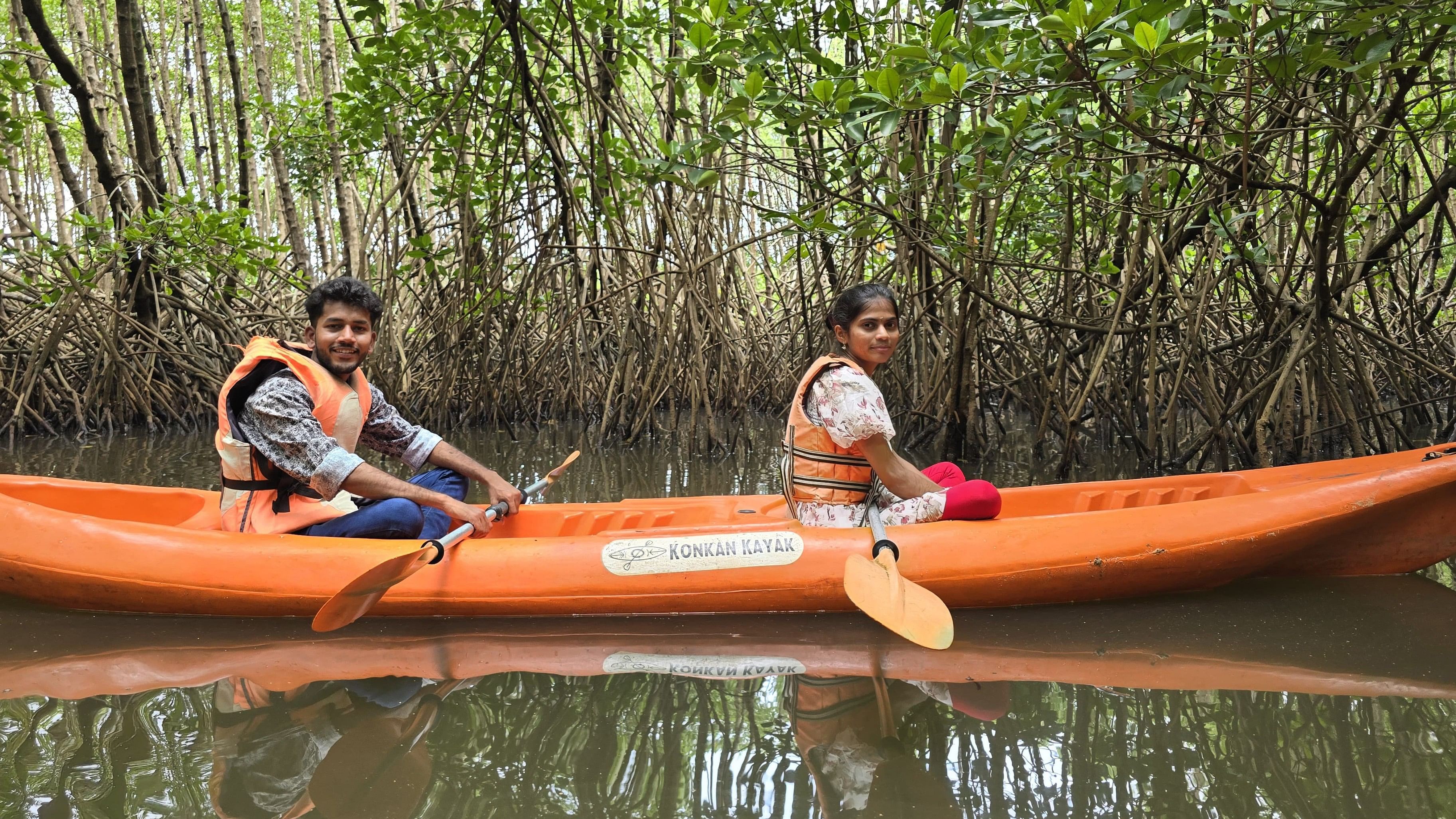
Credit: Special Arrangement
The setting sun disappears from sight, as the boatman, Sashidhar, steers through a narrow passage between thick mangrove forests, paddling with a pole. He offers tourists an enchanting view of the life flourishing around the intricate network of the stilt roots in the marshy land.
As a pair of little cormorants (neeru kaage) dry their wings in the fading light, entering through gaps in canopy, hundreds of red-jointed fiddler crabs (which have one large claw) dart to their hideouts on the soil mound, having emerged at low tide. The sights leave children squealing in delight. A young mother from Kunjarugiri village describes the view excitedly on the phone to a family member.
Mangroves are vital for biodiversity as they serve as nurseries for marine life and habitats for numerous species. Ecologically, they stabilise coastlines, prevent erosion, and act as natural buffers against storms while isolating carbon to combat climate change.
Dakshina Kannada, Udupi and Uttara Kannada districts possess 12.61 square kilometres of mangrove forest, constituting 0.26% of the country’s mangrove coverage. In Uttara Kannada, the mangrove region extends north to the Kali estuary and Gangavali estuary, both located in the Karwar division. Mangroves can also be found south of the Aghanashini estuary, Sharavati estuary and Venkatapura river area in the Honnavar forest division.
Wading through
As Sashidar pushes the pole against the river bed to steer the boat out of the mangrove forest, a couple of students in brightly-coloured kayaks enter the narrow passage to enjoy the glorious view. Steadying his kayak, Steven, a student from Mysuru, says that the kayaking experience has been worth the money. He will soon post reviews online and share his experiences with his friends back in Mysuru, he adds.
This estuary in Saligrama-Parampalli in Brahmavar taluk had remained barren for decades, says Sashidar. Systematic mangrove planting under programmes like MISHTI (Mangrove Initiative for Shoreline Habitats and Tangible Incomes) by the forest department has helped restore estuaries into greener environments, says Vinay Bangera of Zone 51 Kodi, one of the first businesses to introduce kayaking and boat rides in the region.
Environment, economy
Mangrove restoration benefitted the environment and also boosted the village economy, he adds. “Youth like me need not migrate to other cities looking for jobs. Eco-tourism offers part-time jobs to trained students,” he adds. Within a year, as many as four centres offering kayaking have come up on the Saligrama-Parampalli stretch alone, says Vinay, who studied at the National Institute of Water Sports in Goa.
Vinay owns 50 kayaks with a capacity to handle 80 tourists simultaneously. “During weekends, we get over 60 tourists, even from far-off places like Nepal,” he says. An Australian diplomat had visited recently, wishing to boat amidst mangroves, he adds.
Though the mangrove restoration campaign was launched simultaneously across Karnataka’s coastal districts, the Udupi district administration has been proactive in popularising ‘kandla vana’ (mangrove) eco-tourism.
Besides Saligrama-Parampalli, kayaking points have been set up in Kodi and Uppinakudru estuaries, says Deputy Conservator of Forests (Kundapur Division) Ganapathi K. “The panoramic view of mangrove forests attracts both nature lovers and adventure seekers,” says Ganapathi.
Officials say there are plans to introduce a variety of water sports at the kayaking points. In order to enhance the experience, a package including local cuisine and traditions, along with kayaking will be offered to tourists, she adds.
Additional estuaries like the one in Gangolli have been identified for mangrove planting, says Vidyakumari. The Udupi model of kandla vana tourism seems to have inspired Dakshina Kannada, which has 0.45 sq km of mangrove forests and Uttara Kannada, which has 10.47 sq km. Dakshina Kannada has recently started working with local organisations to stop mangrove degradation.
An aerial view of the mangrove forests in Saligrama in Udupi district.
Credit: Manjushree S Naik
A survey identifying kayaking points and the capacity to accommodate tourists in the backwaters is being carried out, says Karwar Tourism Department Deputy Director Jayanth H V. Several steps have been taken to ensure that the region’s ecological balanwce is maintained, says Ganapathi. Kayak points do not allow boats fitted with motors as they tend to cause the erosion of river banks, resulting in the uprooting of mangrove trees, he says.
To protect mangroves amidst eco-tourism development, efforts must be made right from pre-development to monitoring, says environmentalist Jeeth Milan Roche. “Precautions must be taken, including avoiding over-tourism leading to habitat degradation. We should also focus on preventing pollution from tourism and protecting mangrove habitats from coastal development and infrastructure projects,” he says.
Community engagement, collaboration with research institutions and mangrove rehabilitation programmes would go a long way in maintaining a balance between tourism development and conservation, he adds.